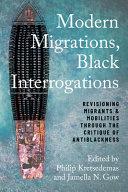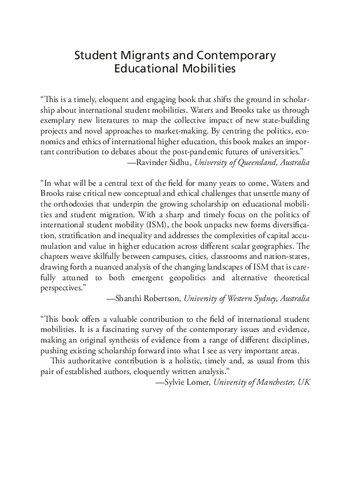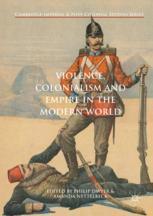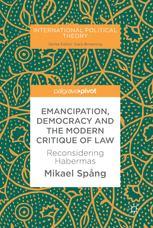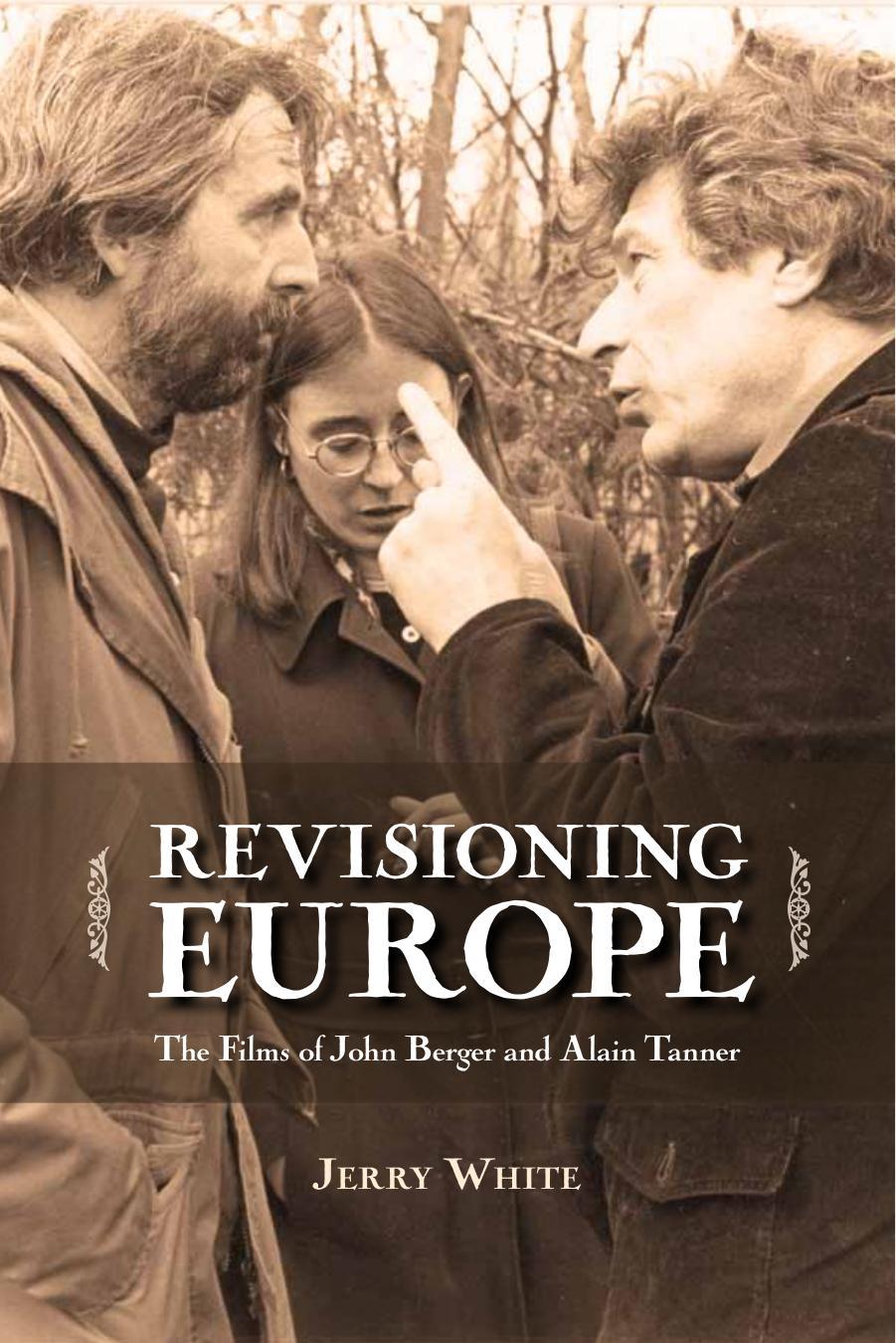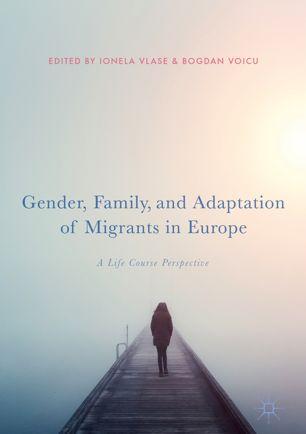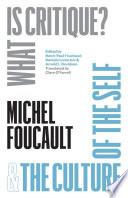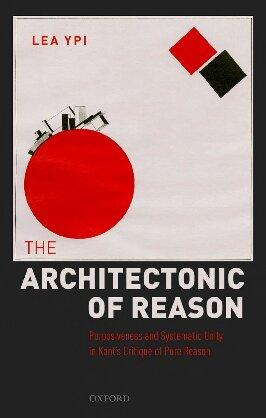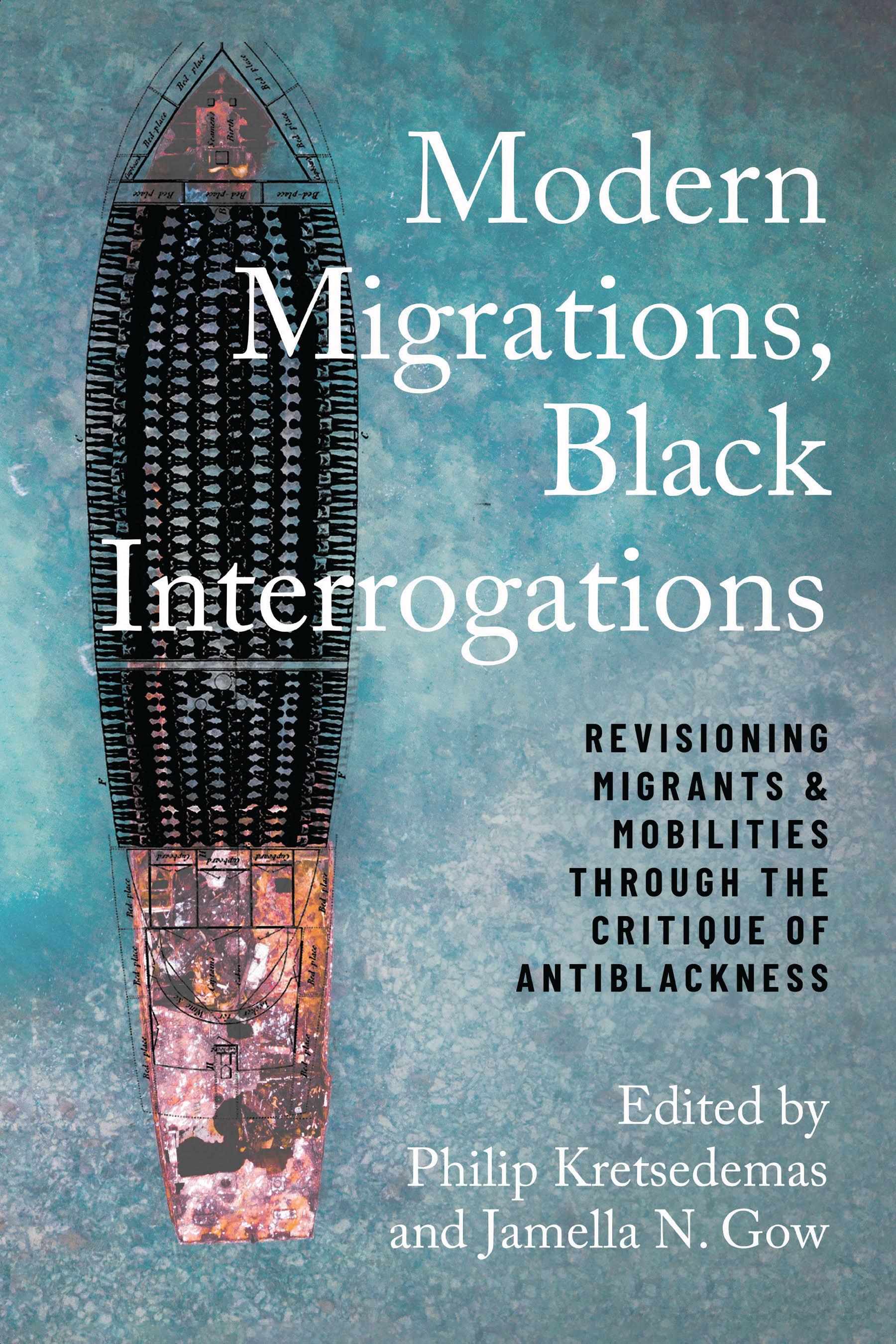Modern Migrations, Black Interrogations
Revisioning Migrants and Mobilities through the Critique of Antiblackness
TEMPLE UNIVERSITY PRESS Philadelphia • Rome • Tokyo
TEMPLE UNIVERSITY PRESS
Philadelphia, Pennsylvania 19122
tupress.temple.edu
Copyright © 2024 by Temple University—Of The Commonwealth System of Higher Education
All rights reserved
Published 2024
Library of Congress Cataloging-in-Publication Data
Names: Kretsedemas, Philip, 1967– editor. | Gow, Jamella N., editor.
Title: Modern migrations, Black interrogations : revisioning migrants and mobilities through the critique of antiblackness / edited by Philip Kretsedemas and Jamella N. Gow.
Other titles: Studies in transgression.
Description: Philadelphia : Temple University Press, 2024. | Series: Studies in transgression | Includes bibliographical references and index. | Summary: “This edited collection applies theories and lessons from the study of antiblack racism to the study of migration and movement. It locates often hidden legacies, resonances, and influences of antiblackness in contemporary migratory regimes”— Provided by publisher.
Identifiers: LCCN 2023025390 (print) | LCCN 2023025391 (ebook) | ISBN 9781439922705 (cloth) | ISBN 9781439922712 (paperback) | ISBN 9781439922729 (pdf)
Subjects: LCSH: Black people—Migrations. | Immigrants—Social conditions. | Emigration and immigration—Social aspects. | Racism against Black people.
Classification: LCC JV6225 .M64 2024 (print) | LCC JV6225 (ebook) | DDC 305.896—dc23/eng/20230909
LC record available at https://lccn.loc.gov/2023025390
LC ebook record available at https://lccn.loc.gov/2023025391
The paper used in this publication meets the requirements of the American National Standard for Information Sciences—Permanence of Paper for Printed Library Materials, ANSI Z39.48-1992
Printed in the United States of America
9 8 7 6 5 4 3 2 1
Black Interrogations: An Introduction / Jamella N. Gow and Philip Kretsedemas
1. E x Aqua in the Mediterranean: Excavating Black Power in the Migrant Question / P. Khalil Saucier and Tryon P. Woods
2. The Immigrant’s Other / Philip Kretsedemas
3. Not Just about Being Haitian, [but] Being Black in America: Race, Gender, and Blackness within the Haitian Diaspora in Miami’s “Little Haiti” / Jamella N. Gow
4. Migration and Lived Experiences of Antiblack Racism: The Case of African Immigrants in Queensland, Australia / Hyacinth Udah
5. A fropessimistic Justice in New York v. Strauss-Kahn and Chimamanda Ngozi Adichie’s Americanah / Maya Hislop
6. Slavery, Migration, and the Genealogies of Blackness in Yaa Gyasi’s Homegoing / Paula von Gleich
Modern Migrations, Black Interrogations
Black Interrogations
An
Introduction
Jamella N. Gow and Philip Kretsedemas
This book recounts the experiences of Black people who have migrated, sometimes across national borders and sometimes not, but it is not a book about Black migration. To be more specific, this is not a book that takes the fact of migration for granted and goes about examining the ways that Black people migrate. For this same reason, this is not a book about Black refugees, even though some of its chapters recount the experiences of Black people who have fled for their lives.
This book uses reflections on the Black experience to trouble and progress the habits of thought that have accreted around the concept of “migration” as it’s been defined for us by researchers and policymakers and by the pundits of the public spheres of the global North. The legacies of the transatlantic slave trade, the centrality of black morphology to the social ontologies of the modern world, and regimes of racialized violence that operate outside of the law (as well as the “social contracts” presumed by the law) will figure into all of our interrogations. The goals and aims of this book are also informed by Fred Moten’s reflections on blackness as “the unasked question.”1 Our aim, as it concerns the field of migration studies, is to break the silence that has stifled the posing of this question, with the understanding that these silences, on the question of blackness, are part and parcel of the antiblack violence that they have enabled and obfuscated. It also bears emphasizing that Moten is not alone in raising this concern. Many scholars have called attention to the long history of silences surrounding the question of blackness in the modern intellectual canon.
This silence can be viewed in light of what Gayatri Spivak has described as the sanctioned ignorance about the relationship between migration and histories of colonial predation that pervade not only migration studies but almost every major subject area of the social sciences and the humanities.2 As Lucy Mablin and Joe Turner have pointed out, the idea of modernity contributes to these silences, by feeding into the belief that European societies, a nd their colonial offshoots, are products of a developmental process that is intrinsic to themselves, rather than growing out of their unequal and codependent relationships with the parts of the world that we now call the global South.3
This investment in the intrinsically different (and superior) qualities of European societies shares purpose with the rational and rugged individualism that has been romanticized by the Western canon. But in this case, we are dealing with a national character rather than an aggregate of private individuals. These ideas have catered to a gendered paternalism, with Western, i ndustrialized nations playing the role of the benevolent, patriarchal adult that is committed to mentoring the more childlike (and implicitly effeminized) nations of the global South.4
It is also important to recognize how the racialized and gendered body comes to be read through the individual as both citizen and nation. Even as masculinity comes to embody the nation in the West, it is frequently women— whether as heteronormative “producers” of citizens or symbolic carriers of national culture—whose bodies become sites for reproducing the nation. While it is white, elite women who are valorized as such, it is Black women and women of color more generally whose presence and ability to reproduce, unless for the purposes of labor, is depicted as a threat to the racialized, gendered, national body.5 The Western national character, then, must also be read as white, male, and heterosexual—a process that removes BIPOC, women, queer, and trans from beyond the borders of citizenship and national belonging.6
When you bring this subtext into view, Spivak’s meditations on sanctioned ignorance should also be read in light of one her most provocative statements about colonial-era power relations, that of “white men saving brown women from brown men.” 7 To unpack this quote a little, Spivak is calling attention to a gender politics that is advanced in the name of women’s rights, but that also reinforces a racial and civilizational hierarchy that was foundational to colonial rule. European colonial powers evidence their cultural superiority by rescuing brown women from their oppressive home cultures. Like Rudyard Kipling’s poem “The White Man’s Burden” and the bucolic depictions of plantation life that were endorsed by the slave-owning classes (and memorialized in films like D. W. Griffith’s film The Birth of a Nation), we are presented with narratives that justify racial domination as being in the best interests of dominated populations.8
These kinds of narratives are still with us, but they take a more nuanced form in the present day. Instead of white men, rescuing brown and black women, as benign patriarchs, this role is played by coalitions of activists, often in consort with state agencies, who leverage feminist and human rights discourse to legitimate their interventions.9 It is important to note that these campaigns are often responding to urgent humanitarian crises and they protect vulnerable people who would otherwise receive no help at all. But they also contribute to a phenomenon that Kelly Oliver has coined “carceral humanitarianism,”10 in which relief efforts become reliant on enforcement solutions that overcriminalize the problems they are trying to correct. As Chandra Mohanty has pointed out, the activists and intellectuals of the global North also have a tendency to conceptualize the oppression of Third World women in ways that affirm the primacy of a white, Western experience of feminism.11 As a result, they fail to see how histories of colonial domination and the contemporary dynamics of North-South economic dependency and military interventions are also women’s issues that require a feminist analysis.
Western feminists’ calls for solidarity around reproductive rights and access to birth control provide a compelling example of where Black feminism a nd Third World feminism diverge. As Black feminists have insisted, Black women have never consistently retained the right to either give birth or keep their own children, even as white feminist politics frame reproductive rights around access to birth control. The right to reproduce and care for children while Black has been shaped by both “controlling images” that serve to villainize Black sexuality and police Black motherhood.12 Similar narratives around family planning in the global South as a positive feature of development echo this rhetoric around the criminality of Black motherhood in the West.13 Calls for revoking birthright citizenship in the United States derives from fears of Black sexuality and childbirth, which is then reframed as fear of the nonwhite immigrant seeking citizenship and welfare for their U.S.-born children. Grace Chang explains: “Just as black women have babies in order to suck up welfare, we are told, immigrant women come to the United States to have babies and consume all of the natural resources in sight.”14 Apprehensions of Black and Third World reproduction are thus tightly interwoven with both the logics of development and the racialized and gendered embodiment of the nation as masculine, patriarchal, and white.
We’ve just described another feature of the sanctioned ignorance that Spivak has written about, which has more to do with the unacknowledged connections between colonization, patriarchal power dynamics, and racism. But it is important, nonetheless, to be mindful about how the silences around these issues dovetail with the silence pertaining to the colonial prehistory of modern migration. Migration scholars have been calling attention to the feminization of international migration for well over two decades.15 Mean-
while, other migration scholars have called attention to how racialized, noncitizen males are disproportionately targeted for deportation.16 These gender disparities, in which racialized women become the prototypical face of exploitable, low-wage migrant labor and racialized migrant men are cast in the role of dangerous, disposable others, can be read in light of a history of race–gender power dynamics, traceable to the colonial era, which is normally kept at arm’s length from migration studies.
The unasked question of blackness belongs to this same species of silences, though as many scholars have noted, it is not exactly the same thing as t he (post)colonial question.17 For example, the (post)colonial gender troubles raised by Spivak do not apply to black women in quite the same way. As Sojourner Truth made very clear in her poem “Ain’t I A Woman,” the white males of the colonial era were not inclined to view black women as deserving of being “rescued.” Black women were, more typically, excluded from the culture of male chivalry (with all of the patriarchal and paternalist undertones that went along with it).18 As Saidiya Hartman has explained, this is also why, under antebellum law, it was impossible for a white man to be convicted of raping a black woman, especially an enslaved black woman.19 Hartman also goes on to reflect on a condition of radical depersonalization that situates the enslaved black body outside of European gender norms. In this era, it was common for white intellectuals to describe black gender relations as a perverse inversion of “normal” (aka white, European) gender norms. 20 But Hartman also describes a more absolute kind of otherness, which leads blackness to become the sign of the subhuman.21 Bodies that suffered under this sign did not have to be treated like “people.” The pleasures that the master derived from the control they exerted over these bodies can be understood as an intoxicating sadism: acting on their desires with no regard for social convention, and with full confidence that they would never be sanctioned for their behavior. This abusive treatment can be reinforced by the objectifying male gaze, but when it comes to black oppression—especially in the antebellum and Jim Crow eras—it is a power that white people of all genders have exerted over black bodies of all genders. Nonetheless, it was enslaved Black women’s positionality as object of labor and sexual violence that a lso led to her vital role in the Black resistance tradition.22 For Black women, sites of gendered violence also became sites of intersectional struggle in ways that reveal the important perspectives gained from gendered Black theorizing.23 Once again, race functions as a hidden transcript that transforms the meaning of gender. We also find it important to emphasize that the imbrications of race and gender can unfold in ways that are more or less unique to t he black condition.
Another distinguishing feature of (anti)blackness is its chronology, which does not align neatly with the history of European colonization. Several schol-
ars observe, for example, that antiblackness was a feature of the European imagination prior to the colonization of the Americas.24 Even more important, antiblackness is a problem that continues to unfold in ways that are qualitatively distinct from the histories of colonization, decolonization, and the postcolonial melancholia that followed in their wake. Antiblackness, in its adaptive fluidity, can be used to explain the habitus and social hierarchies of European settler colonies, but it is also very much alive and well in the multicultural liberal-democratic societies of the present day. Joy James, for example, has shown how Black candidates seeking political office in the multicultural democracies of the global North appeal to antiblack tropes in an attempt to appeal to “mainstream” sentiments.25 Similar observations have been made of the political culture of predominantly Black nation-states, which have undergone their own postcolonial transitions.26 There are also a number of studies showing how racialized immigrants (including Black immigrants) from postcolonial nations integrate into the societies of the global North in ways that keep their social identities at arm’s length from the stigma of blackness.27 This is not to say that blackness and antiblackness are not historically situated and thus immutable across time and space. Adaptability is an important function of how both race and racism persist.28 However, we emphasize that within these versions of race, blackness—wherever it emerges—retains a distinctive character apart from generalized Otherness and other specific forms of racialization.
Keeping these examples in mind, antiblackness is better understood as a constantly regenerating and mutating feature of the present-day organization of social relations rather than as a problem that can be uniquely identified w ith the “transition” from a colonial to a postcolonial or neocolonial social order. In the United States, in particular, the modern silence on the question of blackness seems to have become more entrenched as challenges to the racial order increased in intensity, and as the mechanisms of racial stratification became more complex. Eduardo Bonilla-Silva’s theory of color-blind racism, which has been used to explain the racial ideologies of the post–civil rights era, is one of the most influential attempts to explain this process.29 It bears noting, however, that before color-blind racism came on the scene, there was already a well-established culture of silence on the question of antiblackness and the experiences of Black people.
Although the concept of racism dates to the early twentieth century, it was not originally used to examine the problems faced by Black people.30 Most of the intellectual currents that laid the foundations for the critical study of race and racism today have an even more recent history, which can be traced to the 1980s.31 Moreover, as Aldon Morris has shown, most of the justifications about the “inferiority” of Black populations that were advanced by White intellectuals in the late nineteenth and early twentieth centuries were not based
on empirical research.32 Black populations have been understudied for most of U.S. history despite the fact that late-nineteenth-century treatises on eugenics, which had a pervasive influence on federal and local laws and policies, were anchored by ideas about black inferiority.33 Morris goes on to show that Black scholars attempted to correct this dearth of data by creating their own schools of research that played an instrumental role in getting the social sciences to take empirics more seriously, but they were also excluded from the new research paradigm that they helped to create.34
Morris’s historiography is centered on the life and times of W. E. B Dubois, and it brings to mind Dubois’s fateful observation that the defining problem of the twentieth century was that of the color line.35 Dubois’s prognosis on race and the modern world order is a fitting entry point into the critical intellectual tradition that informs this book. Although Dubois was a disciplined empirical researcher, he understood that blackness posed a problem for the racist imagination that could not be described in practical, measurable terms.36 Blackness is subjected to a metaphysical judgment that is in a constant state of tension with the state of “race relations” as it actually exists. No matter how intimately entangled the black body is in the lives of White persons, it has no place in an idealized future that is anchored in the aspiration to whiteness. Societal progress is a movement toward a world expunged of blackness, which is why—as Dubois observed—Black people who were deemed a “credit to their race” had to be described as exceptional types who were distanced from the existential problem that blackness posed for White society.37
This process, whereby some Black people are provisionally exempted from the excesses of antiblack racism, underscores our earlier observations about the unsettling effect that (anti)blackness can have on gender roles. The Black person who is deemed a “credit to their race” is granted some measure of social status in the eyes of White person. In these assessments there is an objectifying gaze at work that is unique to the terrors of (anti)blackness, but which goes beyond the mere scrutiny of the body.38 A black body that, under different conditions, could be radically excluded and disposed of, and ultimately killed, is treated—within certain limited set of social parameters—as if t hey are the legitimate bearers of an occupational status (whether a teacher, a lawyer, a domestic worker, or a groundskeeper), a political status (a citizen), or a socioeconomic status (as middle class, working class, or even upper middle class). Black embodiment is further interwoven with gender through the attribution of certain bodies as morally upright and bodily pure through linkages between color, body size, and Western beauty.39 The attribution of these qualities to the black body—these qualities of personhood—also allow it to be inducted into the field of “normal” gender roles (the dutiful mother, the respected family patriarch, the bachelor or debutante). Put another way, these
people are “credits to their race” only insofar as they model white, middleclass norms of social conduct and comportment for other, less enlightened members of their race. And the special treatment according to these creditable people also, effectively, legitimizes the radical exclusion of the larger majority of blacks who do not meet this standard.
We want to caution the reader that we are describing a cultural subtext for Dubois’s writing that does not hold true today, the same way it did when he put his thoughts to paper in the early 1900s. We understand that Blackness is an historically mutable field of symbolic meanings that has been contested and negotiated over time, even as the logics of antiblack racism remain.
It also bears noting that critical analyses of (anti)Blackness have called attention to these mutable qualities, perhaps the best example being Hartman’s writing on black fungibility. Hartman uses the concept of fungibility to reflect on the existential condition of radical otherness that haunts these fragile constructions of black personhood.40 According to Hartman, the fungible body is a radically depersonalized object that can be used for any variety of purposes—as a commodity, as an instrument of physical or emotional labor, or a canvas for sadomasochistic desires. These bodies can be useful or desirable, but they have no meaning intrinsic to themselves, and they pose a “problem” the moment they begin to behave in ways that complicate the ontological primacy of the persons whose lives (and societies) they are being used to enhance.
The puzzling thing about this situation, which makes antiblack racism so difficult to diagnose, is that blackness takes on the quality of a thing that “is not”—a thing that is being perpetually erased, in concept or person, by a tactic that rarely addresses its target by name. Laws that target Black populations can be informed by quasi-scientific treatises on black inferiority that a re not directly named by the laws themselves.41 Extralegal measures can be used to exclude and control black bodies that do not show up in the public record, and if a record is made, it can be retroactively expunged to suit the sensibilities of the times.42 But these maneuvers do not eliminate the black presence from day-to-day social relations. Black people appear “everywhere” despite being excluded. In the next section we elaborate further on this strange relationship between blackness and White society with some examples from the history of U.S. immigration law.
Seditious Aliens and Slave Rebellions
In the summer of 1798, a French vessel entered the Delaware Bay containing a crew that included a number of men who were identified by the American colonists as “mulattos,” as well as other people of African descent.43 Prior to this incident there had been mounting hostilities between France and the
recently established U.S. government, which mainly involved altercations at sea.44 Concerns about the suspicious vessel had more to do with its ties to the French government than with the racial composition of its crew. But there were also concerns that these incursions by the French might encourage thousands of Black troops from nearby Haiti to invade the United States and attempt to foment a revolution among the U.S. slave population.45 Although these fears were a little farfetched, the Haitian revolution, which was underway at the time, provided incontrovertible proof that it was possible for enslaved populations to launch a self-organized military campaign. U.S. elites a lso were aware that there was support for the revolution among the Black enslaved population and that some slaves had even managed to escape to Haiti to fight in the war.46
Suffice it to say, the U.S. government was on edge about the possibility of insurrection from a variety of sources. The appearance of the French vessel was the tipping point that has been credited with spurring President John Adams to enact the first of several Alien and Sedition Acts.47 These acts became infamous for being the U.S. government’s first crackdown on civil liberties and immigrant rights, which included an expansion of the government’s deportation powers.48
The Alien and Sedition Acts also became a staging ground for the first major debate in U.S. history over national security versus civil liberties.49 President Adams stood for the Federalist position, in favor of national security and a strong centralized government. The primary spokesperson for the civil liberties position was Thomas Jefferson, who was affiliated with the Democratic-Republican Party and was serving as Adams’s vice president at the time.50
Jefferson was a slave owner. He was also an antislavery moralist, meaning that he was critical of the institution of slavery but was opposed to “radical” proposals for its abolition.51 Like many U.S. slaveholders, he held to a racist double standard, being an avid supporter of the French Revolution and an equally avid opponent of the Haitian revolutionary cause.52
Several years later, Jefferson used popular resentment about the government crackdown on civil liberties as the rallying cry for his presidential campaign. Jefferson won the election and established a Democratic-Republican dynasty that controlled the Executive Office for the next three decades. It also bears noting that Jefferson’s electoral victory was aided by the “votes” of enslaved Black people, votes that, according to the laws of the time, were his to cast as suited his interests—along with the interests of all the other slave owners who supported his presidency. These votes were tallied in such a way that every three “slave votes” counted as one vote.53
Jefferson’s distaste for the deportation powers that were expanded by the Alien and Sedition Acts was rooted in another double standard. What Jefferson mainly opposed was the emergence of a deportation apparatus that
would become a permanent feature of a centralized government. But he was not opposed, in principle, to deportation, and privately he endorsed organized schemes that were geared toward the mass removal of Black people f rom the United States. The American Colonization Society (ACS) was the main vehicle for this agenda, which used the language of “voluntary deportation” and “mass deportation” to describe its plans for creating utopian colonies in the Caribbean or Africa, to which Blacks could be transported in order to form their own self-governing societies.54 Although these deportation proposals were framed as being in the best interests of the U.S. Black population, they never garnered the support of the Black masses, and historians who have studied the ACS have concluded that the common thread that bound the society’s politically diverse membership was its investment in white supremacy.55 Jefferson was a founding member of the ACS, and the two Democratic-Republican presidents who succeeded him also served as presidents of the ACS.56
The details we have just shared draw attention to an antiblack subtext that usually is left out of the story of the Alien and Sedition Acts. When these acts are referenced today, it is usually to recycle a narrative that is not very different from the civil liberties arguments that Jefferson used to rail against the Federalist government in his 1800 election campaign.57 The social ills of xenophobia and intolerance are pinned on the Federalist position, which initiated the crackdown on immigrant rights. Meanwhile, the antiblack racism that was latent to the pro-immigrant position is concealed by a veil of silence.58 This silence is further complicated by the topsy-turvy relationship between the political issues that were at stake in the national security versus civil liberties debate, and the question of Black freedom. For example, although Jefferson was critical of the government’s deportation powers, he was not an ally of the Black crew on the French vessel that triggered the expansion of these powers, and he would never have tolerated the extension of civil liberties or U.S. citizenship to these men. And although Adams was swift to respond to the threat of insurrection posed by this vessel containing these “French Blacks,” he was not as intransigently opposed to the Black freedom movement as was Jefferson. Like Jefferson, Adams was an antislavery moralist, but unlike Jefferson he did not hold slaves and he was opposed to the expansion of slavery in the United States.59 During his presidential term, Adams also sent U.S. war vessels to defend the newly formed Haitian Republic f rom attacks by the French and the British.60 Adams’s interest in keeping a liberated Haiti from falling into the hands of European powers may have been primarily strategic, but whatever the reason, he ended up being a better ally of Haitian democracy than Jefferson.
Instead of concluding that race was irrelevant to all of these maneuvers, it would be more accurate to say that the interests of Black people were ir-
relevant to the debate over civil liberties versus national security, and that this irrelevance was part and parcel of the dehumanization that typifies antiblack racism. The Black population was going to be subject to terror and displacement within the territory of the United States and be threatened with expulsion from the United States, regardless of how this debate was resolved. Black people factored into the debate only by way of the “slave votes” that were conscripted by their owners to defend a system of rights from which they were excluded. This is a practical example of what Black studies scholars mean when they write about the fungibility and deontological status of blackness.
Black Mobility as a Reckoning and Resistance
We have just described a problem that calls attention to the antiblack common sense that has kept the question of Black freedom separate from that of immigrant rights. These antiblack sentiments also help to explain why Black populations have, historically, been singled out for exclusions and controls that have not been applied to (nonblack) immigrants. But we also want to emphasize that Black populations have been targeted by these controls precisely because they have been persistently mobile, and that this mobility can be viewed both in light of, and despite, the inexplicably cruel system of forced removal that was the transatlantic slave trade.
Fugitive Slave Acts and laws targeting free Blacks are testament to the persistence of Black mobilities in the antebellum era.61 After the abolishment of slavery in the Americas, exslaves and their descendants migrated throughout the United States, the Caribbean, and other parts of the Americas seeking better fortunes and refuge and creating new communities.62 Most currents of radical Black politics—including Pan-Africanism, Black Marxism, and other currents of Black postcolonial and anticolonial thought—owe their development to the migrations of Black intellectuals, especially from the Caribbean.63 Many of the Black intellectuals who challenged White Europeans to confront their colonial histories were also migrants.64
The Black experience has to be viewed in light of these interwoven histories of free and forced movement, which is also why Black mobility should be understood as a site of reckoning and resistance. Although Black mobility originates under a regimen of constant surveillance, the historical record shows that Black people thwarted attempts to control their movements at every turn. In the antebellum era, Black people used unauthorized movements as a way to resist enslavement, and in the postbellum era they engaged in similar movements to flee the Jim Crow South and forge transnational alliances.65 This transgressive history of mobility raised issues, many centuries ago, that prefigure the contemporary movement for open borders but that also raise deeper questions about the racial organization of social life.
Immigrant rights coalitions have attempted to make amends for their silence about this history. Efforts have been made to include the Black immigrant experience, in a more deliberate way, in reports on the struggles of undocumented migrants and asylum seekers, and to call attention to migration and adjustment challenges that are experienced by Black people.66 Wellmeaning as they may be, these inclusive overtures do not interrogate the antiblack beginnings of the U.S. immigration regime. We insist, on the other hand, that it is more important to consider how antiblackness can be used to explain the present-day migration regime, rather than figuring out how to better include Black people in discourses on immigration that take the nonblack migrant as their default starting point.
Rethinking Sovereignty, Borders, and Displacement through Antiblackness
The agonies of Black mobility are also reflected in the complicated relationship between blackness, borders, and displacement. Many voices in the contemporary immigrant rights movement have called for the abolition of borders, borrowing from the language that is famously associated with the nineteenthcentury movement to end slavery and, more recently, with the movement for prison abolition.67 This is yet another example of an overture that posits an analogous relationship between the cause of immigrant rights and Black freedom, but without coming to terms with the qualities that are most singular to the Black condition.
If you accept that the transatlantic slave trade is a defining feature of the Black experience in the West, it should be apparent why the call for open borders (or border abolition) does not get to the bottom of Black oppression. The enslaved Africans’ main problem was not that the borders of the Western world were not sufficiently “open” to them. Their problem is that they were ripped out of their home cultures and forcibly transported to another world, where they were incorporated into the total institution of chattel slavery. Furthermore, when it came to the slave trade, the U.S. government’s attempts at border control were a benign intervention—at least, that is, from a n antislavery perspective—since the goal of these operations was to put an end to the international transport and sale of enslaved people.68
After slavery in the United States was abolished, Black people relied on migration as a survival strategy. Black Americans moved north in the Great Migration. Black Caribbean people moved within and outside the Americas.69 The transnational networks established by these migrations laid the foundations for the remittances that most nations in the global South, including most predominantly Black nations, rely on to keep their economies
afloat.70 As is the case for many aspects of the contemporary migration regime, these remittances are necessary in order for people to survive the ravages of global capitalism, but they also replicate the disparities in economic a nd political power that are intrinsic to this system.
Moreover, as the United States expanded its own borders westward, even to territories designated by the state as “free” of slavery, free Black Americans were barred from the opportunity that was envisioned by white settlers.71 In this way, American migratory regimes structured the idea of movement around the exclusion of Black bodies.
David Bacon addresses a comparable problem when he writes about the right to stay home. Bacon came up with this phrase to describe the complaints raised by labor union activists in Latin America who were trying to improve the quality of life in their home communities.72 These activists were struggling to improve wages and worker rights and government investment in the g rassroots economy and local infrastructure, among other issues, so that their community members did not feel that migration was their only choice for a better life. Underlying these efforts is the understanding that, in order for migration to be a decision, the right not to migrate must also be a valid option. People may decide to migrate after carefully weighing the costs and benefits of the decision, but it is a very different thing to migrate because you feel that staying where you are is not an option. When people migrate under these conditions, it becomes increasingly difficult to tell the difference between a migrant and a displaced person. If we focus our attention only on t he right to migrate, we normalize the terrifying experience of displacement as a driving force of contemporary migration.
There is the problem of wealthy nations not being as receptive to displaced populations as they should be and could be. This is the problem of the closed border. There is the problem of expulsion, which can be described as a secondary displacement that leads the migrant or the refugee to be removed after t hey have entered. But there is also the problem of primary displacement, which requires us to face up to the concatenation of social, political, and economic forces that causes people to be uprooted from their homelands in the first place. The Black experience of forced migration focuses attention on this problem.
Even when people migrate under the most desperate of conditions there is a hope, no matter how slim, that things will be better in the new land. The same cannot be said of the transatlantic slave trade. The self-serving narratives of the slaving classes notwithstanding,73 it is reasonable to conclude that the vast majority of Africans who were sold into slavery would have lived a happier life had they never been violently removed from their homelands and branded as “black slaves” in the New World. There is now a considerable body of evidence showing that many African cultures were at a level of social, cul-
tural, and technological development comparable to that of Europe prior to the establishment of the transatlantic slave trade.74 If Europeans had not become involved in the capture and commodification of African bodies for forced labor in their colonies, it is likely that African cultures would have continued to develop in ways that were suitable to their own needs and with much less suffering than was caused by the slave trade and the institutions that were designed to “manage” black populations after emancipation. None of this can be conclusively proven, of course. But neither can it be proven that the world system, which evolved out of Europe’s colonial exploits, was the best possible developmental trajectory for the entire human species. All of these propositions raise questions about the metanarratives that have made migration, modernization, and socioeconomic progress isomorphic to one another.
Perhaps the most important thing a Black perspective offers the field of migration studies is a healthy agnostic attitude toward the secular mythology that insists that migration is necessarily a good thing for the people doing t he migrating. The argument for open borders lends itself to a romanticized idea of the Western industrialized economy as the shining city on the hill— the apex of modern development. Although we agree that the borders of the global North are excessively restrictive, the concern for border abolition overwrites other critical interventions that have called attention to the way the g lobal South has been coercively integrated into the modern world order, which is why we must pay heed to scholars and activists who have insisted on the need for a “delinking” that operates at the level of policy, politics, and orders of knowledge.75 If the open borders argument does not substantively engage this line of critique, it risks devolving into the desperate plea, “Please let us in!”
The Black freedom struggle, on the other hand, is animated by a very different story, of a people who were taken by force to the city on the hill, whose labor made it shine so attractively for the immigrants who wanted to be let in, and who were thrust into a condition of chronic underemployment and controlled by a complex web of surveillance and carceral practices when they could no longer be used as slave labor. When the voices of this freedom struggle call for abolition, they are not saying “Please let us in,” they are demanding to be let go.
If we are going to read antiblack racism into the study of modern migration, we have to come to terms with the genealogical distinction between these t wo histories of struggle. Even though there are such people as Black immigrants, the Black freedom struggle cannot be seamlessly integrated into the struggle for open borders. There are points of tension to wrestle with that are comparable to the agonistic relationship between blackness and immigrant subjectivity. But this is also why the black condition offers an important vantage point for reconceiving borders and bordering practices. We need to re-
frame the right to cross borders and the right to stay put within the context of Black mobility. Going a step further, we must also situate borders, border studies, and bordering practices within the context of antiblackness.
There are some important parallels between this line of critique and critical epistemologies that have been innovated by feminist scholars. Dorothy Smith, for example, has explained how women’s marginality has been normalized by systems of knowledge that are placeless, abstract, and universal.76 She has argued that this Archimedean vantage point, which aims to survey all things from a completely detached intellectual perspective, needs to be replaced by experiential knowledges that account for the social location and the knower (and as other theorists have argued, more forcefully, you cannot account for social location without also considering the social-learned coding of the body). Black, Latinx, Asian, Queer, and Indigenous feminist scholars have advanced similar critical epistemologies that interrogate canonical k nowledge from different social and experiential vantage points.77 The idea of a single, authoritative claim on the truth is replaced by a relational dialogue between multiple perspectives that “see things differently” due to the place they occupy in an unequal field of power relations. Intersectionality theory epitomizes this multivalent and relational take on knowledge creation, though many of its precursors can be traced to second-wave feminist theory, critical race theory, and critical legal studies.78
One lesson that this critical literature offers is a sensitivity to the mutable and relational qualities of borders. Within the field of border studies, it is already well accepted that borders are not static things, but assemblages of practices that are always being tested and renegotiated.79 Feminist, queer, and postcolonial perspectives on the border also underscore the social and embodied nature of borders and bordering practices.80 It is not simply that different kinds of people have different experiences crossing the border. The very composition and enforcement of the border can change radically, depending on the kinds of bodies that approach it. For some bodies, the border checkpoint is just a momentary inconvenience in an otherwise unimpeded trajectory of movement. But for other bodies, the border, and the enforcement powers that go along with it, is an omnipresent reality, even after entering the nation-state. This is not just a question of the policing of the geopolitical borders. It also has to do with the informal ways that institutions and private individuals use gendered and racialized norms to police the borders of t heir networks, which can dovetail, in unexpected ways, with the policing of geopolitical borders.
These lines of inquiry anticipate many of the changes that are already unfolding in the field of border studies (and can also be credited with influencing some of these changes). For example, border studies scholars are giving more consideration to the way that borders are socially constructed and
used not just to demarcate space and place but also to divide and define people, culture, beliefs, and languages.81 Border studies, as an interdisciplinary field, has also taken such studies a step further and insightfully expanded to examine the ways in which “the process of bordering, rather than the border line per se . . . has universal significance in the ordering of society [our emphasis].”82 As border studies scholars and others insist, the making and maintenance of borders involve the act of creating a difference in both institutional and everyday interactive spaces, not just physical lines of division. Hence, borders function not just as a barrier between inside and outside, but also, more critically, as a process and practice that both defines and divides racialized, gendered, and classed bodies as native/foreign, legal/illegal, or citizen/noncitizen.83 We believe that this concept can and should be informed by the ways in which the figure of Blackness has been used as both a line of demarcation and a site of exclusion.
Bordering practices can be enacted through the state, the law, everyday interactions, and on the body. Scholars have introduced the concept of bordering practices to more critically delineate the ways in which the boundaries of the nation-state and of social belonging are themselves performative acts implemented at multiple levels of society.84 The state serves the function of erecting the border, either through the construction of a “wall” or through various systems of filtering entrants, such as visas, citizenship status, and border patrols.
However, state border practices exist not just at its edges of nations but also within them, thus leading to a proliferation of borders and other lines of division.85 Christensen and Albrecht, for example, point to how “the police engage in multiple practices of bordering that constitute, sustain and modify borders.”86 They insist that policing is a form of border work, particularly in urban centers where migrants and refugees often reside. Urban centers, which are depicted as sites of chaos, disorder, and danger, also become sites of control where police are then encouraged to “bring order.” By a ssociating certain spaces as dangerous or in need of control, police and other actors of the state erect borders and mark them as sites of danger and chaos. They also mark those who live within them and cross them as dangerous. Walters, for example, points out that “Borders operate like filters or gateways . . . differentiating the good and the bad, the useful and the dangerous, t he licit and the illicit . . . immobilizing and removing the risky elements so as to speed the circulation of the rest.”87 Border-making thus involves the sorting of people and spaces into safe/unsafe, welcome/unwelcome, and legal/ i llegal.
With the increasing securitization of borders in the post-9/11 era, we have seen the ways in which migrants, refugees, and other movements have become hypercriminalized and surveilled. The U.S.-Mexico border and the
waters and lands bordering the EU offer clear examples of the ways in which borders have been sites of danger and violence, as those who cross are depicted as so-called invaders and are negatively racialized as outside threats to the national body. It is important to recognize the ways in which certain kinds of crossing are read through race—where nonwhite crossers are excluded, or at best, valued for their labor and not their citizenship. Further, i n this volume, P. Khalil Saucier and Tryon P. Woods’s work is instructive in revealing how anti-Blackness pervades both the rhetoric surrounding the border and also the ways in which bordering practices themselves emerge from fears surrounding the specter of the Black body.
Explicating and Interrogating the Borders of (Anti-)Blackness
Border practices are informed not just by race but also by histories of antiBlackness that delineate certain bodies as fully excluded due to their proximity to Blackness. Bordering practices frequently emerge through the construction of racialized boundaries that determine citizenship, legality, and inclusion. We suggest that Blackness itself serves as a boundary or “border” in two ways. First, as we detailed earlier, Black mobility has itself been perceived as a threat or challenge to the border by virtue of its depiction as a harbinger of chaos and the lack of civilization into an otherwise orderly and civilized society within the nation-state. We see such rhetoric in the fear of African and Muslim migrants who are presently seeking entry into Europe. In the United States, since the nation’s early days there has been a fear of Black entry. We discussed, for example, the fear of revolutionary Blacks from the Caribbean, whose actions toward freedom were seen as a threat to U.S/ nation-building and laid the groundwork for the Alien and Sedition Acts. Alongside a fear of Black migration outside the border, there remains a continued unease with the African American subject within the border, whose presence and experiences within the United States have complicated the nation’s origin story as a homogenous, racially white democratic republic. We also want to emphasize that antiblack exclusions can be animated by anxieties about sexuality and gender relations. For much of U.S. history, for example, antiblack violence was legitimized in the name of defending white women and the white family norms.88 Such violence continues to be fueled by anxieties about black fertility and promiscuity (which parallel contemporary fears about Latinx population growth, Latina fertility in particular, which resonates with more recent right-wing discourses on “replacement theory” and “anchor babies”).89
Second, Blackness itself (or the proximity to it) also functions as a racial border to police other racialized groups by offering a potential pathway to
full inclusion. Unlike Black migrants, nonwhite migrants are provided some degree of inclusion into their receiving nations so long as they either remain unwilling to “cross over” into Blackness or are dissuaded from doing so. We can see, for example, how Blackness has served as a bordering practice or dividing line that has determined citizenship (and the ability to exercise it) in the United States. If, as Harris insisted, whiteness was a form of property and citizenship,90 Blackness can then be read as a lack of both. The so-called one-drop rule, for example, can be read as an emphatically Black bordering practice that laid the foundations on which freedom, mobility, and citizenship in the United States relies. To determine Blackness, and who counts w ithin it, then, is to create a border between whether one has the ability to gain and enjoy citizenship and whether one will be counted as human or subhuman.
Blackness has historically served as a racialized bordering practice that shapes the degree to which migrants—white and nonwhite—can gain inclusion. As race and immigration scholars have pointed out, the traditional assimilation framework, which measures the degree of migrant inclusion, is predicated on measuring a migrant community’s racial and socioeconomic distance from Blackness.91 As these scholars argue, phrases such as “downward assimilation” imply a descent into racialized and classed Blackness and, t hrough such phrasing, deemphasize the sway that race and anti-Blackness continues to have on inclusion. Further, migrants themselves recognize this logic.
Bashi Treitler,92 for example, describes how migrant ethnic groups partake in “successful” and “unsuccessful” “ethnic projects” in order to fit within or gain positive entry into the racial hierarchy of the United States. As she points out, delegation into Black identity is perceived as a downgrade on the racial hierarchy and may result in partial or full exclusion. As a result, nonwhite migrants’ claim to ethnic difference can, within the logic of racialized borders, function as a way to distinguish oneself from Blackness and thus allow for the possibility of upward mobility. The unwritten rule of racial inclusion thus states that nonwhite migrants can hope for at least partial exclusion so long as they do not descend into—or cross the border of—Blackness. For migrants who have gained entry into whiteness, the price, as scholars have pointed out, has been the renouncement of Blackness itself and, in some instances, the obligation to reinforce the racialized border.93 Thus, Blackness, through its proximity or mere presence, is itself a racialized border with implications for what constitutes the national body and who can endeavor to gain entry into it. As the authors of this volume point out, in various ways, anti-Blackness is not just another dimension of the way mobility and borders are racialized. In fact, Blackness serves as a key starting point for talking about what constitutes borders and inclusion/exclusion.
(Anti)blackness and Migration: Connecting the Dots
Our opening discussion has called attention to the challenges that the Black experience poses for migration studies. Each of the contributions to this book takes up this challenge, using an analysis of (anti)blackness to rethink the way we understand the border, immigrant identity, barriers to integration, and the dynamics of migrant exclusion, to name just a few examples. Before we move on to a summary of the book’s contents, we think it important to elaborate a little further on how we understand “blackness” and “antiblackness.”
First, the reader has probably noticed that blackness and antiblackness always appear in lowercase letters in our writing and that Black (as well as White and Indigenous) are written as proper nouns, with the first letter of each world capitalized. We are using these lower- and uppercase references to call attention to the difference between blackness as a depersonalizing condition created by antiblack racism (which eviscerates subjectivity) and blackness as a collective force that uses blackness as an experiential starting point for social identities and social processes, which are used by people who identify as “Black” to create life worlds that, by necessity, have to push back against a ntiblack racism. In a similar vein, whiteness and indigeneity are written in lowercase letters (as are immigrant/migrant and so forth) because they describe a diffuse social condition or category, and are written as proper nouns when they reference a more clearly defined subjectivity or collective actor. It might be overly simplistic to read the lowercase letterings as describing a structural condition and the uppercase letterings as describing an agency, though this dichotomy may provide a helpful starting point for readers familiar with social science theory.
It bears emphasizing, however, that the lower- and uppercase letterings carry a special meaning when it comes to Black and blackness. The relationship between (anti)blackness and the Black experience is not quite the same a s the structure/agency dichotomy, as it has been discussed by many sociologists, who treat these concepts as qualitatively distinct but reflexively related phenomena. Black and (anti)blackness, on the other hand, are not just different features of a social landscape—they describe antithetical social realities that are premised on the elimination of the Other. Antiblackness desires a violence against the black body that voids any possibility of agency. Conversely, it is not possible to imagine or inhabit a Black identity without being prepared to inveigh against antiblack desire, in all of its structural and sentimental permutations.
Having acknowledged this much, we left it up to each contributor to decide how to reference this distinction between blackness and Black subjectivity in their own work. Consequently, there is some variation across the chapters in when upper- and lowercase lettering is used, but we think that the more
important point is that these letterings signal the difference between racialization as a desubjectivizing condition and an attempt to reclaim an agency in the face of these racist maneuverings. It also bears noting that while blackness a nd antiblackness are usually written in lowercase letters, they refer to relatively different phenomena. In this case, there is more of a reflexive and interpenetrated relationship, with antiblackness describing the racist sentiments, imaginaries, and ideologies that produce the ocular phenomenon of “ blackness” as a badge of inferiority. The resulting condition, of blackness, is experienced by the people with bodies that are labeled as “black” by the racist. Acceptance of one’s blackness, as it has been defined by the racist, requires some degree of participation in the replication of antiblack desire, but it is not a sufficient “cause,” in of itself, of the forces that propel antiblack racism. Nevertheless, antiblack desire, and the black/nonblack binaries it constructs (which produce blackness as the sign of the fungible, desubjectivized other) can both be distinguished from the collective agencies that we reference through our uppercase letterings for Black mobility, the Black experience, and so forth.
A ll of this goes to underscore that we have a rigorous conceptualization of the difference between Black subjectivity and (anti)blackness, but we also understand that they are expansive and multifarious concepts that can take on different meanings across temporal-spatial contexts. Each of the authors in this volume treats blackness differently and elucidates how antiblackness emerges in various forms across geographies, timelines, cultures, generations, experiences, and other contexts. The variation of themes elaborated on by the authors also emphasizes the ever-changing categories of blackness and consequent manifestations of antiblackness. At times, treatments of antiblackness may parallel other versions of racialized Otherness or vary from the f rameworks or meanings adopted by other chapters in the volume, just as antiblackness co-constructs with the contexts it animates. Still, as we have described here, blackness and antiblackness can be analytically useful to understanding how race and racisms inform mobility, citizenship, sovereignty, borders, and overarching dichotomies of belonging/nonbelonging.
Our treatment of Black subjectivity and antiblackness is also informed by many currents of critical theory, including Black feminist theory, critical race theory, postcolonial studies, and critical currents of migration and refugee studies. It bears noting, however, that Afropessimism has played an especially important role in catalyzing many of the arguments that we have used to frame the book and that are pursued in most of its chapters.
The opening discussion introduced the reader to a number of arguments that have been advanced by Afropessimist scholars, including the thesis on black fungibility and the deontological status of blackness in relation to the modern human, understanding the black/nonblack binary as foundational
to the modern racial order, and understanding the transatlantic slave trade as the structural and material precursor to the black/nonblack binary and the blueprint for the regimens of power that have been imposed on black populations since the end of chattel slavery. Many of the scholars we have cited in these opening pages, such as Frank Wilderson, Saidiya Hartman, Calvin Warren, and Jared Sexton, have made important contributions to Afropessimist theory. Other scholars whose work we have discussed in some depth, such as Aldon Morris and Gayatri Spivak, are not Afropessimists though they have produced analyses that invite a dialogue with arguments from Afropessimist theory. Fred Moten, who is the first scholar we mentioned by name, can also be counted in this group, though he has had a rather complex and contentious relationship to Afropessimist theory.
Our use of upper- and lowercase letterings for Black and (anti)blackness can also be read as an oblique reference to the antagonisms that have been stirred up by Afropessimist theory. From an Afropessimist perspective, blackness can only be understood as a condition of ontological degradation. A meaningful (B/b)lack politics and subjectivity would spell the end of the modern world order as we know it. When we use uppercase lettering for Black mobility, Black migration, and so forth, we are acknowledging, on the other hand, that there can be such a thing as Black agency in an antiblack world. We want to avoid a carelessly optimistic analysis, which, if left to its own devices, leads down the road of color-blind racism—insisting that we are living i n an era in which there no longer any significant structural impediments to Black (social) mobility. But we also think it is important to underline another self-evident fact: that despite seemingly insurmountable odds, Black people have found ways to move of their own accord and to use their mobility as an act of resistance. In a similar vein, Black people are constantly creating and renaming their social identities, launching social movements, and generating knowledge about their experience of race (this book being one such example). Black people have been historically excluded from the modern migration regime, but there is still such a thing as “Black migration” and there a re a great many Black people whose experience of blackness has been mediated through their immigrant identities.
Like the Black experience itself, the book’s contents express the uneasy tension between domination and resistance without resolving it, and we treat Afropessimism in a similar manner. We do not read Afropessimism to mean that black people are unable to experience joy, or that the struggle for Black freedom is a hopeless cause, but we do accept the challenge that Afropessimism poses to the field of migration studies.
The book begins with a pair of chapters that offer a metatheoretical analysis of scholarship that either misses or obfuscates the role of antiblackness i n immigration perspectives. In Chapter 1, Saucier and Woods interrogate
the freedom of movement perspective by pointing out the ways in which it ignores the Black experience of im/mobility and how antiblackness, or social death, underlies the rejection and Othering of migrants and refugees. In Chapter 2, Philip Kretsedemas puts Afropessimist theory in dialogue with Gilles Deleuze and Félix Guattari’s writing on nomadism to explain how Black mobility can be distinguished from other forms of movement, including that of the migrant and the colonial settler, and also of the transgressive mobilities of Indigenous populations.
The next two chapters take a closer look at the contemporary black migrant experience and the ways that antiblackness figures in immigration policy and scholarship. In Chapter 3, Jamella N. Gow studies the experience of Haitian migrants in south Florida and interweaves Black diaspora and Africana studies to uncover how antiblackness and its gendered dimensions inform immigration policy toward Haitians and how Haitian migrants form political identities and community in the diaspora. In Chapter 4, Hyacinth Udah examines antiblack racism in Australia, using a critical race theory perspective to explain how Australian immigration law perpetuates institutional racism and everyday racism in ways that permeate the lives of African migrants.
The final two chapters examine power dynamics and forms of embodiment and racialization that are singular to the experience of Black female migrants. Both chapters engage this topic through the lens of critical literature studies, using a theoretical framework that is defined by a dialogue between Black feminism and Afropessimism. In Chapter 5, Maya Hislop draws parallels between the ways in which Guinean Nafissatou Diallo and Nigerian Ifemelu (the protagonist of Chimamanda Ngozi Adichie’s Americanah) each utilize media to navigate antiblack and sexist tropes alongside their immigrant status to testify about or process sexual trauma. In Chapter 6, Paula von Gleich, like Hislop, examines another cultural work—in this case, Yaa Gyasi’s Homegoing. She explores how, through the lens of Afropessimism and Saidiya Hartman’s concept of “fugitive legacy,” the legacy of slavery and gendered antiblackness inform the shared genealogies of African Americans and Black Americans.
What unites these chapters are key common themes: the long reach of the transatlantic slave trade into the lives and movement of Black people; the ways in which concepts such as immigration, citizenship, identity, belonging, and mobility are informed by and at times grounded in antiblackness; a nd how antiblackness must be intersected with other dimensions of difference such as sexism and xenophobia. In these chapters, the authors define antiblackness through a variety of lenses and explore the Black experience in ways that encompass multiple Black populations across nationalities. However, each chapter begins with the premise that any study of mobility and
